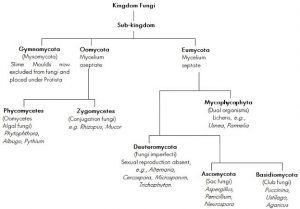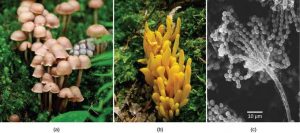MYCOLOGY- FUNDAMENTALS OF FUNGI
- Mycology is the study of fungi. Here, scientists know as mycologist directly focus on the taxonomy, It’s genetics it’s application as well as many other characteristics of this group of organisms.
- Today we have over 50,000 species of identified fungi in different environments across the globe. some are free-living and have no effect on human beings (and other animals), some are either beneficial or harmful making it important to study and understand them.
- It’s important to study the various class of fungi for the development of treatments for diseases caused by specific species of fungi, and also use certain species in a variety of industrial filed (pharmaceutical, food, agriculture and alcohol among others).

GENERAL CHARACTERISTICS OF FUNGI INCLUDE.
- Cell has a cell wall
- Lack chlorophyll
- Eukaryotic
- Heterotrophs
- Use sexual and asexual modes of reproduction (depending on the species)
CLASSIFICATION
- Currently, fungi described as “true fungi” under the fungi kingdom are grouped into several phyla.

- Based on Sexual Reproduction:
- Blastocladiomycota– Members of this phylum are either parasite of plants and animals or saprotrophs. They can be found in both aquatic and terrestrial environments and produce spores that go through meiosis.
- Neocallimastigomycota– Most of the fungi in this group are anaerobic in nature. They can be found in the digestive tract of large herbivores and zoospores move through the use of flagella.
- Glomeromycota– Members of this phylum form a symbiotic relationship with various plants and trees. As such, they are not necessarily parasites that fully depend on the host. The majority of the species reproduce asexually.
- Zygomycota– This is a relatively small group made up of organisms that are referred to as saprobes. As such, they largely depend on decaying organic material as the source of energy.
- A few species, however, are parasitic in nature. Zygomycetes reproduce asexually and produce zygospores. Although species like R. stolonifer obtain their energy from decaying matter (e.g bread) they cause food spoilage and can cause diseases.
- Basidiomycota– Known as club fungi, this phylum is largely composed of mushrooms, smut fungi, and rust. The majority of basidiomycetes are pathogens of grains and tend to produce sexually. Spores of basidiomycetes are referred to as basidiospores.
- Ascomycete– Also known as sac fungi, members of Ascomycota include mushrooms, yeast, truffles, and morels. A majority are filamentous that either exist as parasites or saprophytes.
- However, they can also form symbiotic relationships with other organisms. They produce sexually and basidiospore
- Chytridiomycota– Members of this group are also known as chytrids and produce spores known as zoospores. In aquatic environments, these organisms move using a flagellum and reproduce asexually.
MORPHOLOGY OF FUNGI
- In General Fungi vary wide in size and form, from living thing, microscopic organisms to cellular forms simply seen with the oculus.
- Individual cells vary from one µ to thirty µ. Microscopic fungi exist as either molds or yeasts or each. Internally, fungous cells square measure fairly typical being cells.
MOLDS
- The molds kind massive cellular aggregates of long branching filaments, known as hyphae. There square measure vegetative hyphae and generative hyphae.
- Spores square measure borne on the generative hyphae. (Fungal spores mustn’t be confused with microorganism spores that square measure resistant bodies fashioned for microorganism survival instead of generative functions.)
- reproductive structure size, form and structure square measure utilized in the classification and identification of fungi.
- The tube-like hyphae square measure chargeable for the downy look of the macroscopic mildew colony.
- The hyphae associate degreed alternative structures mix to make an elaborate network known as a plant colon.
YEASTS
- These square measure massive (5 to eight µ), acellular organisms that seldom kind filaments. Most yeasts reproduce by the agamous method of budding.
- Yeast colonies square measure sometimes characterised by a sleek surface just like that of the many bacterium.
STRUCTURE AND PHYSIOLOGY OF FUNGI
- There is wide variation within the structure, size, and quality of assorted fungous species. for instance, fungi embrace the microscopic yeasts, the molds seen on contaminated bread, and also the common mushrooms.
MOLDS
- Molds consist of long, branching filaments of cells called hyphae (singular, hypha). A tangled mass of hyphae visible to the unaided eye is a mycelium (plural, mycelia).
- In some molds, the protoplasm passes through and among cells of the fibril uninterrupted by cross walls.
- These fungi square measure the same to be coenocytic fungi. Those fungi that have cross walls square measure called septate fungi, since the cross walls square measure known as septa.
YEASTS
- Yeast is microscopic, living thing fungi with one nucleus and organism organelles.
- They reproduce asexually by a method of budding. during this method, a replacement cell forms at the surface of the initial cell, enlarge, then breaks liberally to assume associate degree freelance existence.
- Some species of fungi have the power to shift from the yeast kind to the mildew kind and the other way around. These fungi are dimorphic.
- Several fungous pathogens exist within the body within the yeast kind however revert to the mildew kind within the laboratory once cultivated.

References

